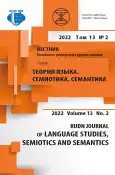The Perception of Medical Doctors on the Part of Hindu, Russian and Kazakh Linguoculture Bearers: Association Experiment
- Autores: Kuzembayeva G.A.1, Maigeldiyeva Z.M.2, Maydangalieva Z.A.3
-
Afiliações:
- K. Zhubanov Aktobe Regional University
- Korkyt Ata Kyzylorda University
- Baishev University
- Edição: Volume 13, Nº 2 (2022)
- Páginas: 567-580
- Seção: COMPARATIVE STUDIES
- URL: https://journal-vniispk.ru/2313-2299/article/view/323514
- DOI: https://doi.org/10.22363/2313-2299-2022-13-2-567-580
- ID: 323514
Citar
Texto integral
Resumo
The objective of the article is to study the perception of medical doctors by Hindu, Russian and Kazakh linguoculture bearers by means of cognitive analysis of association data obtained from the psycholinguistic experimental study conducted among Hindi, Russian and Kazakh native speakers. Methods of the research include a free association experiment with a stimulus words डॉक्टर in Hindi, врач in Russian, and дəрігер in Kazakh, modelling the associative field DOCTOR and its cognitive structure, defining the universal and ethno-specific features of medical doctors as perceived by the representatives of Indian, Russian and Kazakh nations. The obtained associative data were distributed according to the frequency criterion, followed by content analysis and categorization. As a result, while comparing association fields in Hindi, Russian, and Kazakh languages the quantitative asymmetry of semantic zones and their associates is revealed. Conceptualization of medical doctors in the Hindu, Russian and Kazakh language consciousness includes both universal and ethno-specific features. The results of the study integrate the experiences of different nations simplifying the perception of their peculiarities, and may have a positive impact on cross-cultural interactions.
Palavras-chave
Sobre autores
Gulzhana Kuzembayeva
K. Zhubanov Aktobe Regional University
Email: kuzembayeva@mail.ru
ORCID ID: 0000-0001-8964-3683
Ph.D. in Philology, Associate Professor of the Department of English and German Languages
7А, Grishina str., Aktobe, the Republic of Kazakhstan, 030000Zhannat Maigeldiyeva
Korkyt Ata Kyzylorda University
Email: jmussabek@mail.ru
ORCID ID: 0000-0003-1297-274X
Candidate of Philological Sciences, Associate Professor of the Department of Russian Language and Literature
29А, Aiteke Bi str., Kyzylorda, the Republic of Kazakhstan, 120000Zhumagul Maydangalieva
Baishev University
Autor responsável pela correspondência
Email: maydangalieva@mail.ru
ORCID ID: 0000-0003-3189-8880
Ph.D. in Education, Associate Professor of the Department of Foreign Languages and Literature
302А, br. Zhubanovykh str., Aktobe, the Republic of Kazakhstan, 030000Bibliografia
- Morel, D.A., Spivak, L.N. & Shatilina, S.I. (2015). Stereotypical risks and threats in the youth’s opinion (diachronic comparative aspect). Scientific result. Issues of theoretical and applied linguistics, 1(4 (6)), 4-7.
- Galton, F. (1879). Psychometric experiments. Brain, 2, 149-162.
- Russell, W.A. & Jenkins, J.J. (1954). The Complete Minnesota norms for Responses to 100 Words from the Kent-Rosanoff Word Association Test. Minneapolis: Minnesota of University.
- Cramer, P. (1968). Word Association. London: Academic Press.
- Postman, L. (1970). Norms of Word Association. New York: Academic Press.
- Leontiev, A.A. (1993). Language Consciousness and Image of the World. In: Tarasov, E.F. (Ed.) Language and Consciousness: The Paradoxical Rationality. Moscow: RAN Institute of Linguistics. pp. 16-21. (In Russ.).
- Nelson, D.L., McEvoy, C.L. & Schreiber, T.A. (1998). The University of South Florida word association, rhyme, and word fragment norms. Behavior Research Methods, Instruments, & Computers, 36, 402-407.
- Vygotsky, L.S. (1999). Thinking and Speech. Moscow: Labyrint. (In Russ.).
- Zalevskaya, A.A. (2007). Introduction to Psycholinguistics. Moscow: Russian State Humanitarian University. (In Russ.).
- De Deyne, S. & Storms, G. (2008). Word Associations: Network and semantic properties. Behavior Research Methods, 40/1, 213-231.
- Kovács, L., Orosz, K. & Pollner, P. (2012). The network of Hungarian word associations. Magyar Tudomány, 6, 699-705.
- Gravino, P., Servedio, V.D.P., Barrat, A. & Loreto, V. (2012). Complex structures and semantics in free word association. Advances in Complex Systems, 15(3-4). URL: https://hal.archivesouvertes.fr/hal-00701709/document (accessed: 12.01.2022).
- Ufimtseva, N.V. (2014). Russian Psycholinguistics: Contribution to the Theory of Intercultural Communication. International Communication Studies, XXIII:1, 1-13.
- Lenart, I., Markovina, I. & Endrődy, O. (2021). Preschool Children’s Verbal Image of the World: A Cross-Cultural Russian-Hungarian Comparison Based on Word Associations. Journal of Tomsk State University. Philology, 72, 91-118. https://doi.org/10.17223/19986645/72/5
- Dmitryuk, N. & Abramova, G. (2021). Associative Dictionaries as an Ethnic Mental Phenomenon: Basic Values in the Core of Ethnic Group Language Consciousness. Psycholinguistics, 30 (2), 59-84.
- Goroshko, E.I. (2006). Linguistic consciousness: Gender paradigm. Saint-Petersburg: Aleteyya. (In Russ.).
- Nedashkivska, T. & Kushmar, L. (2017). Associative Way from Perception to Understanding: Associative Field vs Lexical-Semantic Field. Journal of Modern Education Review, 7(1), 44-50.
- Karaulov, Yu.N. (2000). National mentality indicators in an associative-verbal network. In: Ufimtseva, N.V. (Ed.) Language consciousness and image of the world. Moscow: RAN Institute of Linguistics. рр. 191-206. (In Russ.).
- Madzhayeva, S.I. (2010). Verbalization of concept doctor - linguacultural and cognitive aspects. Scientific Statement. Humanities, 24 (95), 18, 152-156. (In Russ.).
- Kubryakova, Ye.S., Demyankov, V.Z., Pankrats, Yu.G. & Luzina, L.G. (1996). Concise dictionary of cognitive terms. Мoscow. (In Russ.).
- Abramova, G., & Dmitryuk, N. (2021). Edification Dictums in the Language Consciousness of the Kazakh Ethnos. Psycholinguistics, 29 (2), 8-24. https://doi.org/10.31470/2309-1797-2021-29-2-8-24
Arquivos suplementares









